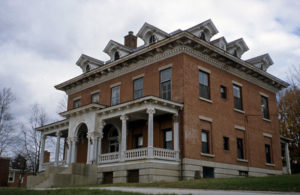 Before the arrival and settlement by European settlers, the area in Norwich now known as Jail Hill was the strategic site of a fort for the Mohegan tribe. At two hundred and thirty feet, the summit of the hill provided a panoramic view of the confluence of the Shetucket, Thames and Yantic Rivers. In 1659, Uncas the chief sachem of the Mohegan tribe sold the hill as part of the transaction with the first English settlers for the original “nine square miles” of land that would later become Norwich.
Before the arrival and settlement by European settlers, the area in Norwich now known as Jail Hill was the strategic site of a fort for the Mohegan tribe. At two hundred and thirty feet, the summit of the hill provided a panoramic view of the confluence of the Shetucket, Thames and Yantic Rivers. In 1659, Uncas the chief sachem of the Mohegan tribe sold the hill as part of the transaction with the first English settlers for the original “nine square miles” of land that would later become Norwich.
The hill remained almost entirely undeveloped until the early nineteenth century. The Norwich Female Academy was established in 1828 with an enrollment of ninety pupils. The Norwich historian, Frances Caulkins began her career as a teacher at the school. In 1834, a decision to construct the city jail on the south slope of the hill would forever alter the direction of the future development of the area that became Jail Hill. Despite the beautiful vistas afforded from the heights of the hill, the existence of the jail deterred the affluent residents of Norwich from building their homes there. Due to the subsequent low property values, the area became a burgeoning neighborhood for poor and working class citizens.
African American families normally unable to afford their own homes were able to get a foothold as property owners on Jail Hill. The Second Congregational Church on Jail Hill had established a Sabbath School in 1815 conducting literacy lessons for black adults and children. The church formed the nucleus an expanding African American community on Jail Hill and its connections with the growing national abolitionist movement.
Residents on the hill, Charles Harris and his brother William were subscription agents for the abolitionist newspaper The Liberator published by William Lloyd Garrison. Charles Harris’ daughters Sarah and Mary attended the Prudence Crandall School which advocated for the educational opportunities for black children.
Another prominent black resident on Jail Hill was James Lindsey Smith who had escaped from slavery in Virginia in 1838. He made his way North via the Underground Railroad assisted by Norwich-born David Ruggles. Smith, a minister and a shoemaker by trade eventually moved into a house on School Street. His autobiography detailing his life during and after slavery was published in 1881.
To view photographs of some the historic buildings and homes of the residents of Jail Hill, go to the link for the Flickr page on the Otis Library’s website.
